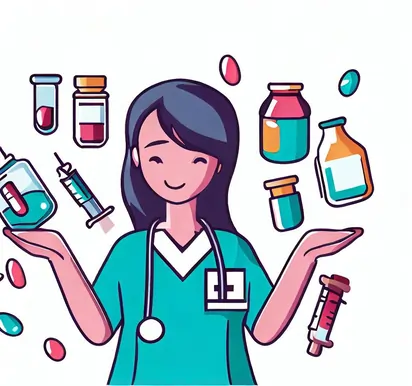Pharmacology for Nurses: Understanding Drug Administration and Patient Safety

Common Medications
Antibiotics
Antibiotics such as penicillin, amoxicillin, and ciprofloxacin play a pivotal role in combating bacterial infections, but their administration is not without challenges. Nurses bear a significant responsibility in this regard, starting with the verification of any known allergies to antibiotics. This crucial step helps avoid severe allergic reactions, which could lead to anaphylactic shock—a life-threatening condition. Additionally, nurses must actively monitor patients for side effects like gastrointestinal upset, which could manifest as nausea, vomiting, or diarrhea. These symptoms not only compromise patient comfort but could also lead to dehydration and electrolyte imbalances. Nurses also need to keep an eye out for signs of allergic reactions like rashes, itching, or difficulty breathing. Timely identification and reporting of such side effects can help healthcare providers make necessary adjustments to the treatment regimen, thereby optimizing patient safety and therapeutic outcomes. Overall, antibiotic administration is a nuanced task that requires keen attention to detail and an in-depth understanding of pharmacological principles.

Antihypertensives
Managing high blood pressure is a critical healthcare task, often requiring medications such as amlodipine, lisinopril, and metoprolol. Nurses play an indispensable role in hypertensive care, particularly in administering these medications and assessing their impact. Regular and accurate blood pressure monitoring is essential, as it provides crucial data on medication effectiveness. These readings can serve as a basis for dose adjustments or even a switch in medication type, decisions generally made in consultation with healthcare providers. Monitoring is not just a one-time event but a continuous process, as blood pressure can fluctuate due to various factors such as stress, diet, and other medications. Additionally, nurses must be vigilant for potential side effects like dizziness or palpitations. Their observations, recorded meticulously, contribute significantly to patient safety and the optimization of treatment protocols. Through consistent monitoring and collaboration with other healthcare professionals, nurses ensure the pharmacological management of high blood pressure is both effective and safe.
Analgesics
Pain management is a critical aspect of patient care, and nurses are often at the forefront of administering medications like acetaminophen, ibuprofen, and opioids. The first step is a thorough evaluation of the patient's pain level, typically assessed using a standardized pain scale. This assessment helps to determine the appropriate medication and dosage. Post-administration, nurses must reassess the pain levels to gauge the medication's effectiveness. Equally important is vigilant monitoring for side effects. Opioids, for example, carry a significant risk of respiratory depression, a potentially life-threatening condition. Signs of this could include shallow or slowed breathing, and immediate intervention is required if this occurs. Side effects like gastrointestinal issues or potential liver damage from acetaminophen should also be on a nurse's radar. The detailed observations and documentation by nurses form an essential link in achieving effective pain management while minimizing risks.
Antidiabetics
Managing diabetes involves a multi-faceted approach, and nurses are pivotal in this care pathway. The administration of drugs like metformin and insulin requires not only precision but also consistent monitoring of blood glucose levels. Nurses help ensure that medications are effectively controlling sugar levels, reducing the risk of complications like hyperglycemia or hypoglycemia. Additionally, nurses are often the primary source of patient education on lifestyle modifications, such as diet and exercise, that can improve diabetic outcomes. Their guidance can empower patients to better manage their condition, reinforcing the medical treatment plan and enhancing overall health.
Anticoagulants
Anticoagulants like warfarin, heparin, and rivaroxaban are crucial in preventing blood clots, but they come with the heightened risk of bleeding. Nurses play a critical role in balancing this delicate equation. Vigilant monitoring for signs of bleeding—such as unusual bruising, bloody stools, or prolonged nosebleeds—is essential. Nurses are also responsible for regularly checking coagulation parameters, like the INR (International Normalized Ratio), to ensure that the medication is effectively preventing clotting without causing excessive bleeding. Their meticulous observations and timely interventions can be lifesaving, making their role indispensable in anticoagulant management.
Side Effects and Interactions
Medications are double-edged swords: while they treat specific conditions, they can also introduce a host of side effects and interactions. Nurses must be vigilant in monitoring for common side effects like gastrointestinal upset, dizziness, or allergic reactions. Additionally, the risk of drug interactions is a crucial concern. A patient's medication could interact adversely with other drugs, foods, or pre-existing conditions. For example, antihypertensives may interact with grapefruit juice, amplifying their effects. Nurses need to educate patients on potential interactions and closely observe them for unexpected reactions. This proactive approach is essential for optimizing drug efficacy while minimizing risks. Some common side effects include:
- Gastrointestinal upset: Common in antibiotics and some analgesics.
- Drowsiness: Common in antihistamines and some antipsychotics.
- Hypotension: A known side effect of antihypertensives.
- Bleeding: Especially in patients on anticoagulants.
Drug interactions can either reduce the effectiveness of the medication or lead to toxicity.
For instance:
- Warfarin and Vitamin K: A diet high in vitamin K can diminish the effect of warfarin.
- Antibiotics and birth control: Some antibiotics can reduce the effectiveness of hormonal contraceptives.
Safe Administration Practices
The "Five Rights" of medication administration serve as a foundational guideline for nurses to ensure patient safety and reduce medication errors. These rights offer a systematic approach for the complex, multi-step process that begins when a healthcare provider prescribes a medication and continues through to its administration and post-administration monitoring.
- Right Patient: Verifying the patient's identity is a crucial first step. Utilizing at least two identifiers, such as name and date of birth, can help avoid administering medication to the wrong patient. Sometimes, barcode scanning technology is also used for this purpose.
- Right Medication: Double-checking the medication involves verifying that the medication pulled from the pharmacy or dispensing unit matches the healthcare provider's order. It's also essential to check the expiry date to ensure that the medication is still effective.
- Right Dose: Confirming the dosage entails cross-referencing the prescribed amount with the healthcare provider's orders. Dosing errors can result in significant adverse outcomes, including drug toxicity or ineffectiveness.
- Right Route: It's crucial to ensure the medication is administered via the correct route, be it oral, intravenous (IV), subcutaneous, or another method. Wrong-route errors can severely impact the medication's effectiveness and could pose serious risks.
- Right Time: Medications often have a specific timing to maximize therapeutic effects and minimize side effects. Administering the medication as per the times specified in the prescription ensures optimal efficacy.
Strictly adhering to these "Five Rights" not only minimizes the potential for errors but also enhances the overall quality of healthcare delivery. Each "Right" serves as a checkpoint, a moment to pause and confirm, thereby integrating safety into the very fabric of routine medication administration. Nurses are the last line of defense against medication errors, making their adherence to these guidelines essential for patient safety. Documentation. Every medication administration should be thoroughly documented, including the drug name, dose, route, and any observed side effects or patient complaints.
Patient Education
Patient education is a cornerstone of effective healthcare, particularly when it comes to medication management. Nurses should inform patients about their prescribed medications, possible side effects, and any potential interactions with other drugs or foods. Providing written material can reinforce oral instructions and serve as a handy reference for patients. Encouraging patients to ask questions fosters an environment of open communication, allowing for clarification and additional information sharing. This multi-pronged educational approach not only empowers patients to be active participants in their care but also minimizes the risks of medication errors or adverse reactions.
Monitoring
Monitoring for therapeutic effectiveness and adverse reactions is a vital nursing responsibility that directly impacts patient outcomes. For example, regular blood pressure checks are imperative for patients on antihypertensives to assess if the medication is effectively controlling hypertension. Nurses should also be alert to any signs of medication side effects or adverse reactions, such as dizziness or skin rashes, which may warrant adjustments to the treatment plan. Through rigorous monitoring and timely reporting to healthcare providers, nurses play a pivotal role in ensuring that medications not only achieve their therapeutic goals but also maintain patient safety.
Conclusion
Pharmacology for nurses extends far beyond simple drug administration. It encompasses a nuanced understanding of how medications work, how they can impact the body, and how they interact with other substances. Nurses play a vital role in ensuring not only that medications are administered safely but also in monitoring for effectiveness and potential side effects. By understanding common medications, being aware of possible side effects and interactions, and adhering to safe administration practices, nurses can significantly contribute to improved patient outcomes and safety. Remember, you're not just administering medication; you're administering care, attention, and knowledge. The more you understand about pharmacology, the more effectively you can fulfill your essential role in patient care. Whether you're a nursing student or a practicing nurse, continually updating your pharmacological knowledge can make a considerable difference in your professional journey and your patients' lives. Keep learning, keep questioning, and keep caring.